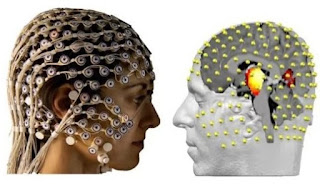The subcortical areas of the
brain, situated in its deepest reaches, remain a mystery. Scientists are aware
of the critical role they play in motor, emotional and associative activity but
do not know precisely how they work. A number of serious diseases are directly
linked to these areas, including Parkinson’s, Tourette syndrome and
obsessive-compulsive disorders (OCD). Existing treatments for regulating and
measuring the activity of the subcortical areas are highly invasive, and
sometimes work without us really knowing how. Researchers from the University
of Geneva (UNIGE), Switzerland, and Cologne University (Germany) decided to see
whether a non-invasive method – electroencephalography (EEG) – could be
employed in tandem with mathematical algorithms to measure this brain activity
externally. They proved for the first time that this technique is able to
record signals usually only seen by implanting electrodes in the brain.
Current treatments, based on deep
brain stimulation are highly invasive: implanting electrodes into the centre of
the brain, which are stimulated electrically by an external stimulator.
Although this technique has been shown to be effective in Parkinson’s,
unfortunately it doesn’t work so well for OCD and Tourette syndrome. Since
implanting electrodes is an extremely invasive technique, another method was
called for to increase the number of subjects studied. Researchers were able to
measure and record the electrical activity of the subcortical areas of four OCD
and Tourette’s patients who had been given electrode implants. At the same
time, these individuals were equipped with an EEG as the scientists measured
the activity of the same areas from the surface. The mathematical algorithms
that they developed meant that they could accurately interpret the data
provided by the EEG and ascertain where the brain activity was coming from.
More information:
